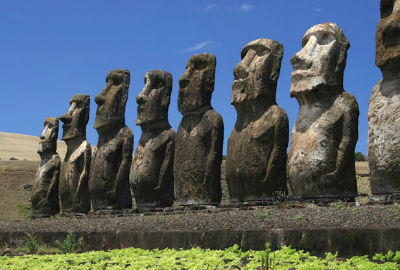 The massive 887 stone statues or moai built in Easter Island by the Rapa Nui are unique.
The massive 887 stone statues or moai built in Easter Island by the Rapa Nui are unique.Although there are stone figures in other Polynesian islands none of them are of the size of the Easter Island statues. The largest finished statue reaches more than 30 feet or 9.14 meters and the smallest 6 feet or 1.80 meters. Many moai were never finished, in fact the largest one found was unfinished and would have stood at 70 feet or 21.34 meters tall.
The moai are upright, humanlike figures with large heads and stylized angular faces, prominent noses, ears and lips, most of them have hollow eye sockets which were once filled with white coral and red stones. Not all the moai have their eyes filled, it is believed that only the most prominent ones had them filled during special ceremonies. Their bodies are long and end at their hips, their arms are at its sides and their hands with long fingers wrapped in front of their abdomen.
The moai were carved from soft volcanic tuff which is formed when volcanic ash hardens and compresses. The statues were carved on site and then moved to the desired location. Most of the statues found at Easter Island were carved at Rano Raraku which is a volcanic cone formed by the eruption of Maunga Terevaka, the largest volcano in the island. This tuff was the perfect material for statue carving; carvers made the best out of each section of the volcano and used the rock from inside and outside the crater walls. Their creations had to be perfect, if they found a defect in the rock the statue was abandoned and moved on to another section. About 400 finished and unfinished moai can be seen inside the crater and laying on the nearby grassy slopes.
Moai carvers where skilled stone cutters and honored craftsmen. From oral tradition scholars have concluded that these artists were part of a privileged class fully dedicated to carving statues. The tools used by the Rapa Nui are called toki, they were sharp picks made out of basalt, a hard volcanic rock. The moai were carved in the walls of the crater. The first step was to outline the shape of the body with its back attached to the ground by a thin keel which was only chipped away when the carving was complete. When the front of the statue was finished it had to be removed from its keel and slid carefully down the slope of Rano Raraku. To accomplish this difficult task they used ropes to tie the statue to tree trunks. At the bottom of the crater the statue was erected and its back carved, they gave the moai its final touches and smoothed its surface with coral.
The moai are upright, humanlike figures with large heads and stylized angular faces, prominent noses, ears and lips, most of them have hollow eye sockets which were once filled with white coral and red stones. Not all the moai have their eyes filled, it is believed that only the most prominent ones had them filled during special ceremonies. Their bodies are long and end at their hips, their arms are at its sides and their hands with long fingers wrapped in front of their abdomen.
The moai were carved from soft volcanic tuff which is formed when volcanic ash hardens and compresses. The statues were carved on site and then moved to the desired location. Most of the statues found at Easter Island were carved at Rano Raraku which is a volcanic cone formed by the eruption of Maunga Terevaka, the largest volcano in the island. This tuff was the perfect material for statue carving; carvers made the best out of each section of the volcano and used the rock from inside and outside the crater walls. Their creations had to be perfect, if they found a defect in the rock the statue was abandoned and moved on to another section. About 400 finished and unfinished moai can be seen inside the crater and laying on the nearby grassy slopes.
Moai carvers where skilled stone cutters and honored craftsmen. From oral tradition scholars have concluded that these artists were part of a privileged class fully dedicated to carving statues. The tools used by the Rapa Nui are called toki, they were sharp picks made out of basalt, a hard volcanic rock. The moai were carved in the walls of the crater. The first step was to outline the shape of the body with its back attached to the ground by a thin keel which was only chipped away when the carving was complete. When the front of the statue was finished it had to be removed from its keel and slid carefully down the slope of Rano Raraku. To accomplish this difficult task they used ropes to tie the statue to tree trunks. At the bottom of the crater the statue was erected and its back carved, they gave the moai its final touches and smoothed its surface with coral.
Once the moai was completely finished it had to be moved to its final location. Moving the moai was a challenge in itself, many of them were destroyed on its way. The average moai weighs 10 tons and its final location was as far as 14 miles or 22.5 kilometers. The first step was to move the moai from quarry was to establish a line wrapped around a log placed upright in the ground to make lowering easier while the crew assisted by holding a lever. Next the moai is secured in a sled made by logs which would be pulled by the crew along the track. According to scholars who tested this theory it is estimated that an average moai could have been moved from the quarry to Ahu Akivi in less than 5 days, using approximately 70 men. The last step was the positioning of the moai onto the ceremonial platforms or ahu. A stone ramp was built to assist in levering the moai into the ahu, people used logs as levers.
We will never know exactly how the moai were transported the mystery will remain with us. However by modern experiments researches have been able to replicate the transportation of the moai, which from a distance appear to be walking just as the legend suggests.
We will never know exactly how the moai were transported the mystery will remain with us. However by modern experiments researches have been able to replicate the transportation of the moai, which from a distance appear to be walking just as the legend suggests.
By - Chile Culture












